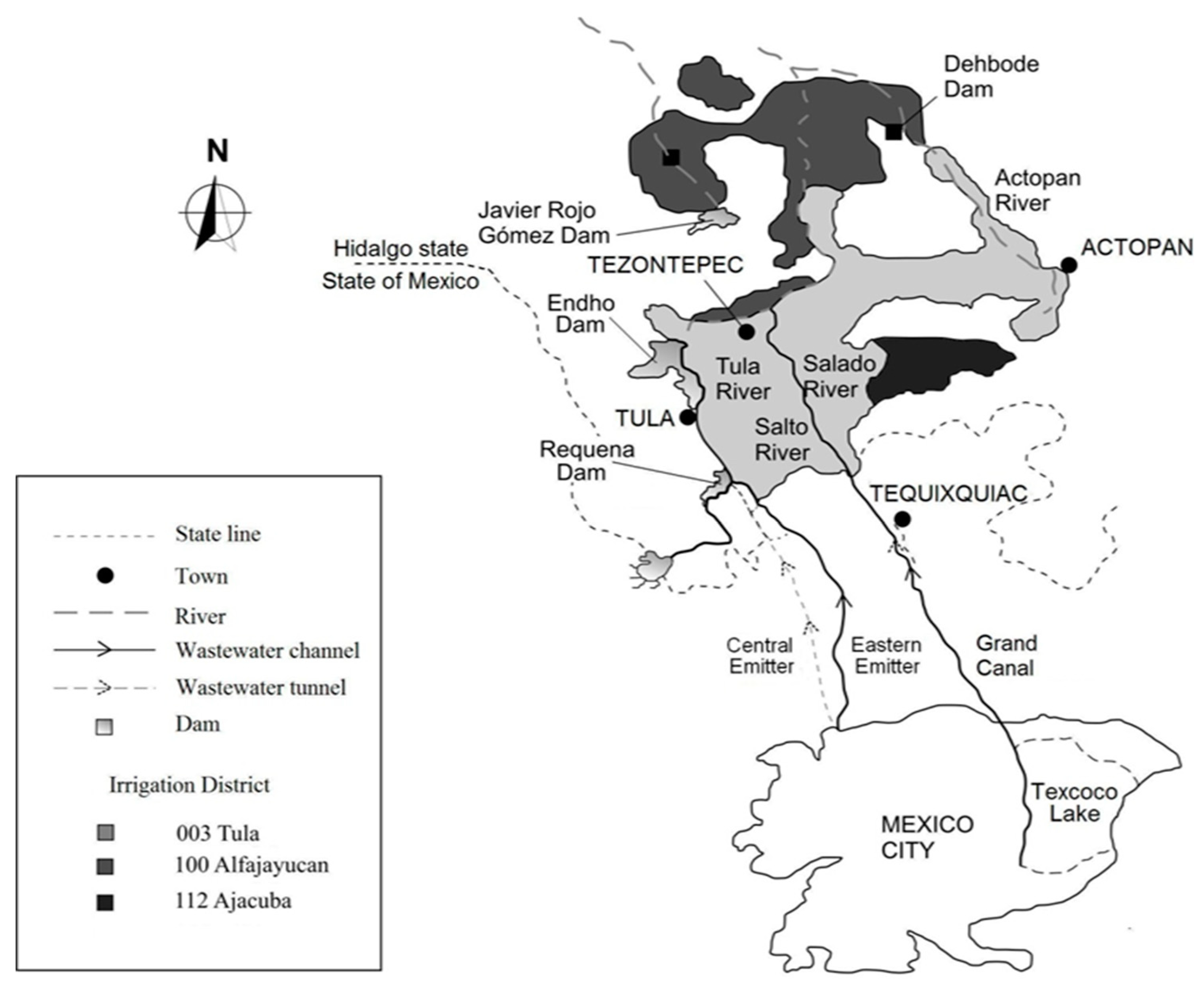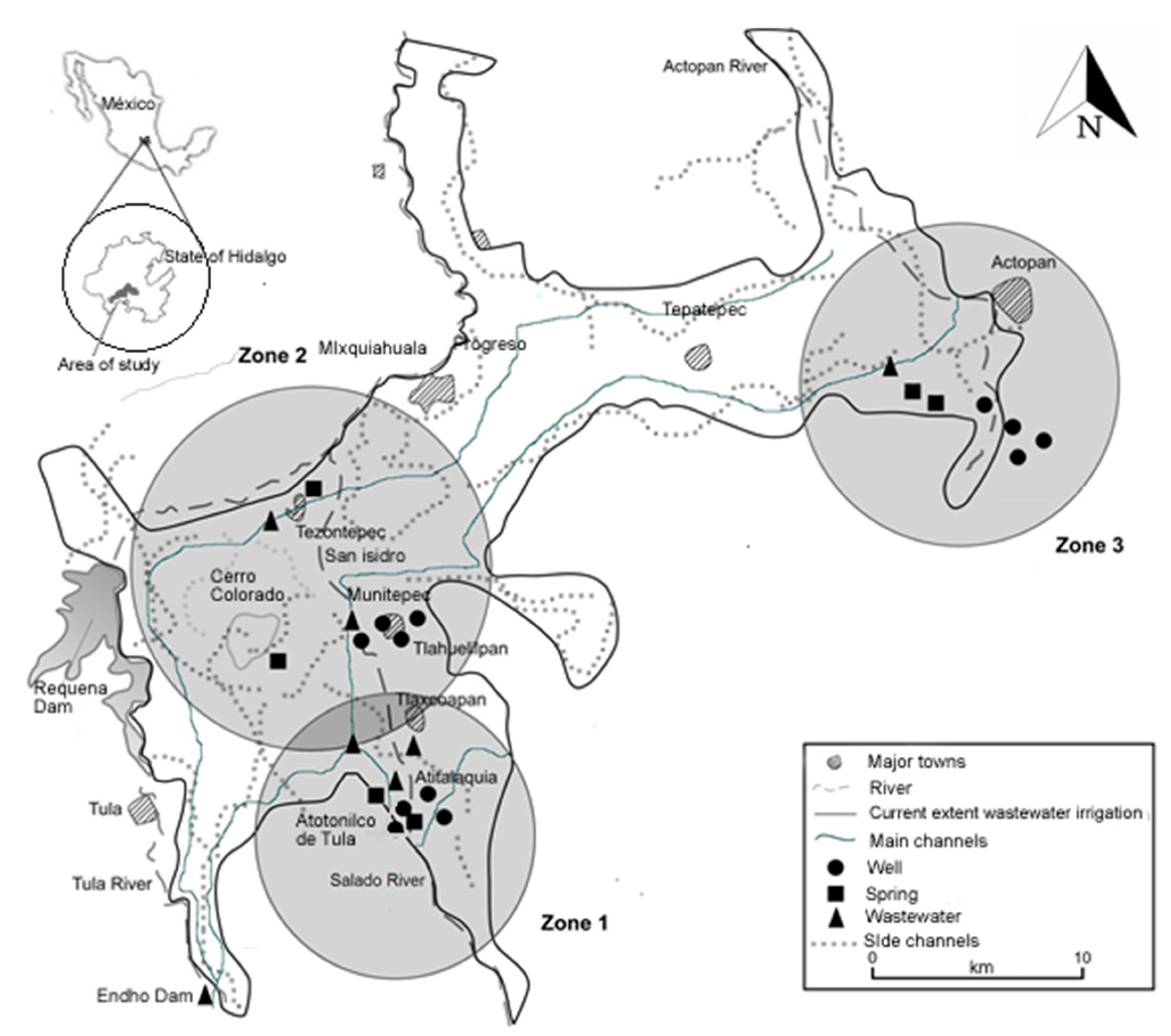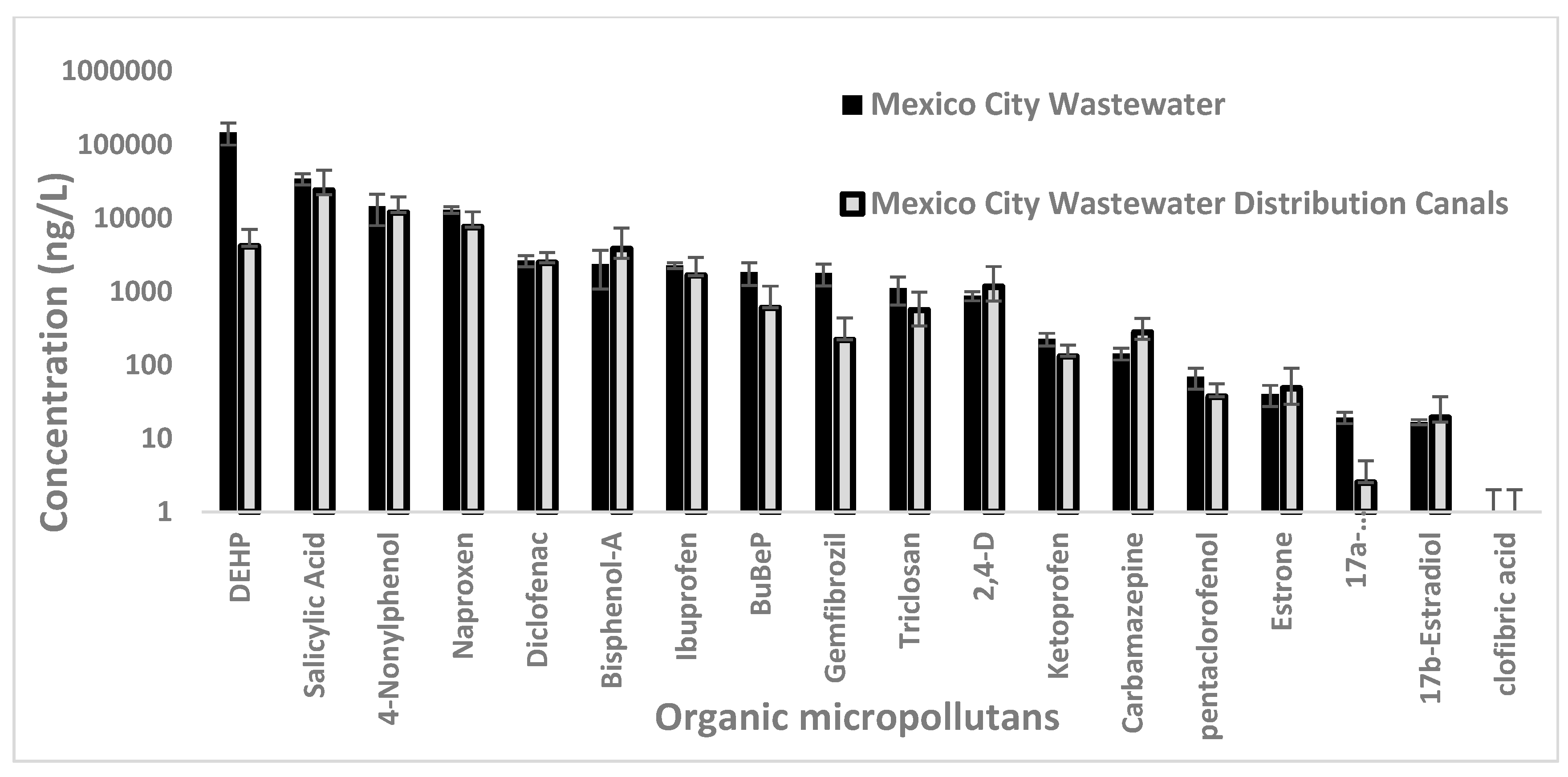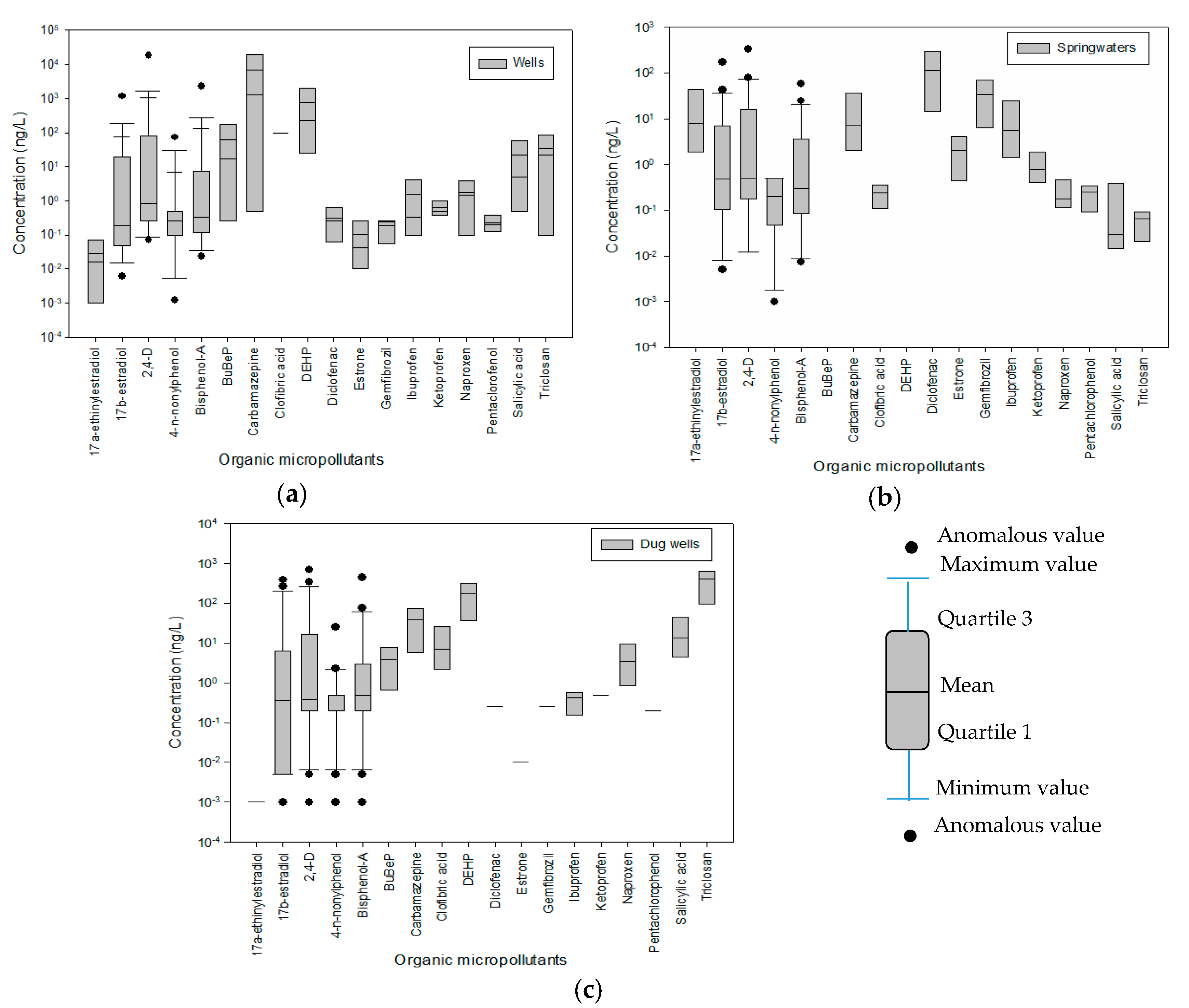Presence and Natural Treatment of Organic Micropollutants and their Risks after 100 Years of Incidental Water Reuse in Agricultural Irrigation
Abstract
1. Introduction
2. Materials and Methods
2.1. Sampling
2.2. Estimation of OMPs
2.3. Estimation on Human Health Risks
3. Results and Discussion
3.1. Estimation of OMPs
3.2. Estimation on Human Health Risks
4. Conclusions
Author Contributions
Funding
Acknowledgments
Conflicts of Interest
References
- Jimenez-Cisneros, B.; Chávez-Mejía, A.C. Low cost technology for reliable use of Mexico City’s wastewater for agricultural irrigation. Tecnology 2010, 9, 95–108. [Google Scholar]
- Comisión Nacional del Agua (CONAGUA). Water Statistics in Mexico; Secretaría de Medio Ambiente y Recursos Naturales (SEMARNAT): Mexico City, Mexico, 2010. (In Spanish) [Google Scholar]
- Gutiérrez-Ruiz, M.E.; Siebe, C.; Sommer, I. Effects of land application of wastewater from Mexico City on soil fertility and heavy metal accumulation: A bibliographical review. Environ. Rev. 1995, 3, 318–330. [Google Scholar] [CrossRef]
- Jimenez, B.; Chavez, A. Quality assessment of an aquifer recharged with wastewater for its potential use as drinking sources: “El Mezquital Valley Case”. Water Sci. Technol. 2004, 50, 269–276. [Google Scholar] [CrossRef] [PubMed]
- Hao, C.; Zhao, X.; Yang, P. GC-MS and HPLC-MS Analysis of bioactive pharmaceuticals and personal care products in environmental matrices. Trends Analyt. Chem. 2007, 26, 569–580. [Google Scholar] [CrossRef]
- Santos, L.H.M.L.M.; Araújo, A.N.; Fachini, A.; Pena, A.; Deleure-Matos, C.; Montenegro, M.C.B.S.M. Ecotoxicological aspects related to the presence of pharmaceuticals in the aquatic environment. J. Hazard. Mater. 2010, 175, 45–95. [Google Scholar] [CrossRef] [PubMed]
- Kolpin, D.W.; Furlong, E.T.; Meyer, M.T.; Thurman, E.M.; Zaugg, S.D.; Barber, L.B.; Buxton, H.T. Pharmaceuticals, hormones and other wastewater contaminants in U.S. streams, 1999–2000: A national reconnaissance. Environ. Sci. Technol. 2002, 36, 1202–1211. [Google Scholar] [CrossRef]
- Barnes, K.K.; Kolpin, D.W.; Furlong, E.T.; Zaugg, S.D.; Meyer, M.T.; Barber, L.B. A national reconnaissance for pharmaceuticals and other organic wastewater contaminants in the United States – I) Groundwater. Sci. Total Environ. 2008, 402, 192–200. [Google Scholar] [CrossRef]
- Focazio, M.J.; Kolpin, D.W.; Barnes, K.K.; Furlong, E.T.; Meyer, M.T.; Zaugg, S.D.; Barber, L.B.; Thurman, M.E. A national reconnaissance for pharmaceuticals and other organic wastewater contaminants in the United States—II) Untreated drinking water sources. Sci. Total Environ. 2008, 402, 201–216. [Google Scholar] [CrossRef]
- Benotti, M.J.; Trenholm, R.A.; Vanderford, B.J.; Holady, J.C.; Stanford, B.D.; Snyder, S.A. Pharmaceuticals and endocrine disrupting compounds in U.S. drinking water. Environ. Sci. Technol. 2009, 43, 597–603. [Google Scholar] [CrossRef]
- Meek, M.E.; Chan, P.K.L. Bis(2-ethylhexyl) phthalate: Evaluation of risks to health from environmental exposure in Canada. J. Environ. Sci. Health C 1994, 12, 179–194. [Google Scholar] [CrossRef]
- EFSA. Scientific Opinion on the risks to public health related to the presence of bisphenol-A (BPA) in foodstuffs: PART II—Toxicological assessment and risk characterization. EFSA J. 2015, 13, 621. [Google Scholar] [CrossRef]
- IARC. IARC Monographs—101 DI(2-ETHYLHEXYL) PHTHALATE. International Agency for Research in Cancer, Monographs on the Evaluation of Carcinogenic Risks to Humans. Available online: https://monographs.iarc.fr/iarc-monographs-on-the-evaluation-of-carcinogenic-risks-to-humans-15/ (accessed on 23 May 2019).
- UNEP-WHO. State of the SCIENCE of Endocrine Disrupting Chemicals—Summary for Decision-Makers; Bergman, Å., Heindel, J.J., Jobling, S., Kidd, K.A., Zoeller, R.T., Eds.; Endocrine Disrupting Chemicals—Summary for Decision-Makers; UNEP WHO: Nairobi, Kenya, 2012; Available online: https://apps.who.int/iris/bitstream/handle/10665/78102/WHO_HSE_PHE_IHE_2013.1_eng.pdf;sequence=1 (accessed on 23 May 2019).
- Downs, T.J.; Cifuentes, E.; Ruth, E.; Suffet, I. Effectiveness of natural treatment in a wastewater irrigation district of the Mexico City region: A synoptic field survey. Water Environ. Res. 2000, 72, 4–22. [Google Scholar] [CrossRef]
- Chávez, A.; Maya, C.; Durán, J.; Becerril, A.; Gibson, R.; Jiménez, B. The removal of microorganisms and organic micropollutants in a large scale unplanned soil aquifer treatment. Environ. Pollut. 2011, 159, 1354–1362. [Google Scholar] [CrossRef]
- Chávez, A.; Torner, F.; Barrios, J.A.; Maya, C.; Lucario, E.; Navarro, M.I.; Jiménez, B. Membrane process for spring water treatment in the Tula Valley. Assessment of physicochemical and microbiological parameters in a non-conventional water source. Water Sci. Technol. Water Supply 2015, 15, 294–301. [Google Scholar] [CrossRef]
- Lesser, L.E.; Mora, A.; Moreau, C.; Mahlknecht, J.; Hernández-Antonio, A.; Ramírez, A.I.; Barrios-Piña, H. Survey of 218 organic contaminants in groundwater derived from the world’s largest untreated wastewater irrigation system: Mezquital Valley, Mexico. Chemosphere 2018, 198, 510–521. [Google Scholar] [CrossRef]
- Gibson, R.; Becerril-Bravo, E.; Silva-Castro, V.; Jiménez, B. Determination of acidic pharmaceuticals and potential endocrine disrupting compounds in wastewaters and spring waters by selective elution and analysis by gas chromatography-mass spectrometry. J. Chromatogr. A 2007, 1169, 31–39. [Google Scholar] [CrossRef]
- Schwab, B.W.; Hayes, E.P.; Fiori, J.M.; Mastrocco, F.J.; Roden, N.M.; Roger, D.C.; Meyerhoff, D.; D’Aco, V.J.; Anderson, P.D. Human pharmaceuticals in US surface waters: A human health risk assessment. Regul. Toxicol. Pharmacol. 2005, 42, 296–312. [Google Scholar] [CrossRef]
- Houtman, C.J.; Kroesbergen, J.; Lekkerkerker-Teunissen, K.; Van der Hoek, J.P. Human health risk assessment of the mixture of pharmaceuticals in Dutch drinking water and its sources based on frequent monitoring data. Sci. Total Environ. 2014, 496, 54–62. [Google Scholar] [CrossRef]
- Semerjian, L.; Shanableh, A.; Semreen, M.H.; Samarai, M. Human health risk assessment of pharmaceuticals in treated wastewater reused for non-potable applications in Sharjah, United Arab Emirates. Environ. Int. 2018, 121, 325–331. [Google Scholar] [CrossRef]
- Sharma, B.M.; Bečanová, J.; Scheringer, M.; Sharma, A.; Bharat, G.K.; Whitehead, P.G.; Klánová, J.; Nizzetto, L. Health and ecological risk assessment of emerging contaminants (pharmaceuticals, personal care products, and artificial sweeteners) in surface and groundwater (drinking water) in the Ganges River Basin, India. Sci. Total Environ. 2019, 646, 1459–1467. [Google Scholar] [CrossRef]
- Snyder, S.A.; Trenholm, R.A.; Snyder, E.M.; Bruce, G.M.; Pleus, R.C.; Hemming, J.D.C. Toxicological Relevance of EDCs and Pharmaceuticals in Drinking Water; AWWA Research Foundation: Denver, CO, USA, 2008. [Google Scholar]
- Navarro, I.; Jimenez, B.; Maya, C.; Lucario, E.S. Assessment of potential cancer risk from trihalomethanes in: Water supply at Mexican rural communities. In Proceedings of the International Symposium on New Directions in Urban Water Management, UNESCO-IHP, Paris, France, 5 September 2007. [Google Scholar]
- Yang, Y.Y.; Toor, G.S.; Wilson, P.C.; Williams, C.F. Micropollutants in groundwater from septic systems: Transformations, transport mechanisms, and human health risk assessment. Water Res. 2017, 123, 258–267. [Google Scholar] [CrossRef] [PubMed]
- Kümmerer, K. Pharmaceuticals in the Environment: Sources, Fate, Effects and Risks; Springer: Berlin/Heidelberg, Germany; New York, NY, USA, 2004. [Google Scholar]
- Murillo-Torres, R.; Prado, B.; Durán-Álvarez, J.C. Jiménez-Cisneros, retención de 4-nonilfenol y di(2-etilhexil)ftalato en suelos del Valle de Tula, Hidalgo (B.; 4-nonylphenol and bis(2-ethylhexyl) phthalate: Retention in soils from the Tula Valley, Hidalgo). Tecnol. Cienc. Agua. 2012, 3, 113–126. (In Spanish) [Google Scholar]
- Durán-Álvarez, J.C.; Sánchez, Y.; Prado, B.; Jiménez, B. The transport of three emerging pollutants through an agricultural soil irrigated with untreated wastewater. J. Water Reuse Desalin. 2014, 4, 1–9. [Google Scholar] [CrossRef][Green Version]
- Davies, R.P.; Dobbs, A.J. The prediction of bioconcentration in fish. Water Res. 1984, 18, 1253–1262. [Google Scholar] [CrossRef]
- Dalkmann, P.; Siebe, C.; Amelung, W.; Schloter, M.; Siemens, J. Does long-term irrigation with untreated wastewater accelerate the dissipation of pharmaceuticals in soil? Environ. Sci. Technol. 2014, 48, 4963–4970. [Google Scholar] [CrossRef]
- Cordy, G.E.; Duran, N.L.; Bouwer, H.; Rice, R.C.; Furlong, E.T.; Zaugg, S.D.; Meyer, M.T.; Barber, L.B.; Kolpin, D.W. Do pharmaceuticals, pathogens, and other organic waste water compounds persist whenwaste water is used for recharge? Ground Water Monit. Remediat. 2004, 24, 58–89. [Google Scholar] [CrossRef]
- Bodzek, M.; Dudziak, M. Elimination of steroidal sex hormones by conventional water treatment and membrane processes. Desalination 2006, 198, 24–32. [Google Scholar] [CrossRef]
- Ying, G.G.; Kookana, R.S.; Dillon, P. Sorption and degradation of selected five endocrine disrupting chemicals in aquifer material. Water Res. 2003, 37, 3785–3791. [Google Scholar] [CrossRef]
- Lai, K.M.; Schimshaw, M.D.; Lester, J.N. Prediction of the bioaccumulation factors and body burden of natural and synthetic estrogens in aquatic organisms in the river systems. Sci. Total Environ. 2002, 289, 159–168. [Google Scholar] [CrossRef]
- Birkett, J.W.; Lester, J.N. Endocrine Disrupters in Wastewater and Sludge Treatment Processes; Lewis Publishers and IWA Publishing: Boca Raton, FL, USA, 2003. [Google Scholar]
- Stackelberg, P.E.; Gibs, J.; Furlog, E.T.; Meyer, M.T.; Zaugg, S.D.; Lippincot, R.L. Efficiency of conventional drinking- water-treatment processes inremoval of pharmaceuticals and other organic compounds. Sci. Total Environ. 2007, 377, 255–272. [Google Scholar] [CrossRef]
- Staples, C.; Peterson, D.; Parkerton, T.; Adams, W. The environmental fate of phthalate esters: A literature review. Chemosphere 1997, 35, 667–749. [Google Scholar] [CrossRef]
- Byrns, G. The fate of xenobiotic organic compounds in wastewater treatment plants. Water Res. 2001, 35, 2523–2533. [Google Scholar] [CrossRef]
- Drillia, P.; Stamatelatou, K.; Lyberatos, G. Fate and mobility of pharmaceuticals in solid matrices. Chemosphere 2005, 60, 1034–1044. [Google Scholar] [CrossRef]
- Castillo, I.M.; Barcena, P.C. Pentaclorofenol: Toxicología y riesgos para el ambiente. (Penthachlorophenol: Toxicology and risks for the environment). Madera y Bosques. 1998, 4, 21–37. [Google Scholar] [CrossRef][Green Version]
- Siemens, J.; Huschek, G.; Siebe, C.; Kaupenjohann, M. Concentrations and mobility of human pharmaceuticals in the world’s largest wastewater irrigation system Mexico City-Mezquital Valley. Water Res. 2008, 42, 2124–2134. [Google Scholar] [CrossRef]
- Durán-Álvarez, J.C.; Prado-Pano, B.; Jiménez-Cisneros, B. Sorption and desorption of carbamazepine, naproxen and triclosan in a soil irrigated with raw wastewater: Estimation of the sorption parameters by considering the initial mass of the compounds in the soil. Chemosphere 2012, 88, 84–90. [Google Scholar] [CrossRef]
- Hillis, D.G.; Fletcher, J.; Solomon, K.R.; Sibley, P.K. Effects of ten antibiotics on seed germination and root elongation in three plant species. Arch. Environ. Contam. Toxicol. 2011, 60, 220–232. [Google Scholar] [CrossRef]
- Pan, M.; Wong, C.K.C.; Chu, L.M. Distribution of antibiotics in wastewater irrigated soils and their accumulation in vegetable crops in the Pearl River Delta, Southern China. J. Agric. Food Chem. 2014, 62, 11062–11069. [Google Scholar] [CrossRef]
- Zaharin, A.A.; Shamsuddin, A.S.; Praveena, S.M. Occurrence of 17α-ethinylestradiol (EE2) in the environment and effect on exposed biota: A review. Environ. Int. 2014, 69, 104–119. [Google Scholar]
- Rąpała, M.; Pluciński, B.; Jedynak, P. The effect of bisphenol A on growth, pigment composition and photosystem II activity of Arabidopsis thaliana. Acta Biochimica Polonica 2017, 64, 407–413. [Google Scholar] [CrossRef]
- Dokyung, K.; Kwak, J.L.; An, J.L. Physiological response of crop plants to the endocrine-disrupting chemical nonylphenol in the soil environment. Environ. Pollut. 2019, 251, 573–580. [Google Scholar] [CrossRef]
- Yan, L.; Huang, G.; Gu, H.; Huang, Q.; Lou, C.; Zhang, L.; Liu, H. Assessing the risk of phthalate ester (pae) contamination in soils and crops irrigated with treated sewage effluent. Water 2018, 10, 999. [Google Scholar] [CrossRef]
- Carter, L.J.; Harris, E.; Williams, M.; Ryan, J.J.; Kookana, R.S.; Boxall, A.B.A. Fate and uptake of pharmaceuticals in soil−plant systems. J. Agric. Food Chem. 2014, 62, 816–825. [Google Scholar] [CrossRef]
- Martínez-Piernas, A.B.; Nahim-Granados, S.; Polo-López, M.I.; Fernández-Ibáñez, P.; Murgolo, S.; Mascolo, G.; Agüera, A. Identification of transformation products of carbamazepine in lettuce crops irrigated with Ultraviolet-C treated water. Environmental Pollution. 2019, 247, 1009–1019. [Google Scholar] [CrossRef]
- Picó, Y.; Alvarez-Ruiz, R.; Alfarhan, A.H.; El-Sheikh, M.A.; Alobaid, S.M.; Barceló, D. Uptake and accumulation of emerging contaminants in soil and plant treated with wastewater under real-world environmental conditions in the Al Hayer area (Saudi Arabia). Sci. Total Environ. 2019, 652, 562–572. [Google Scholar] [CrossRef]
- Coady, K.; Matthiessen, P.; Zahner, H.M.; Staveley, J.; Caldwell, D.J.; Levine, S.L.; Gray, L.E.; Borgert, C.J. Endocrine disruption: Where are we with hazard and risk assessment? Peer J. Prepr. 2016, 4. [Google Scholar] [CrossRef][Green Version]
- Vandenberg, L.N.; Blumberg, B. Alternative approaches to dose–response modeling of toxicological endpoints for risk assessment: Nonmonotonic dose responses for endocrine disruptors. In Comprehensive Toxicology, 3rd ed.; Elsevier Ltd.: Oxford, UK, 2018; Volume 1, pp. 39–58. [Google Scholar]
- Herre, A.; Siebe, C.; Kaupenjohann, M. Effect of irrigation water quality on organic matter, Cd and Cu mobility in soils of Central Mexico. Water Sci. Technol. 2004, 50, 277–284. [Google Scholar] [CrossRef]
- Bartrons, M.; Peñuelas, J. Pharmaceuticals and personal-care products in plants. Trends Plant. Sci. 2017, 22, 194–203. [Google Scholar] [CrossRef]
- Mzukisi, M.L.; Ncube, S.; Chimuka, L. Uptake of pharmaceuticals by plants grown under hydroponic conditions and natural occurring plant species: A review. Sci. Total Environ. 2018, 636, 477–486. [Google Scholar] [CrossRef]
- Muhammad, A.; Song, X.; Wang, Y.; Francis, D.; Yang, Y. Environmental impact of estrogens on human, animal and plant life: A critical review. Environ. Int. 2017, 99, 107–119. [Google Scholar] [CrossRef]




| Sampling Points | Name Local Name of Identification | West | North | * Distance (km) |
|---|---|---|---|---|
| Zone 1. Raw wastewater from Mexico City without any treatment | ||||
| Well 1 Well 2 Well 3 Well 4 Spring 1 Dug well 1 Central Emmiter WW Canal 1 WW Canal 2 | Tezoquipa Principal la Cantera El Tablón Pozo San Primitivo Rancho Nápoles (las albercas) Fam. González López Emisor Central Canal de Riego (Tequizquiac) Canal Salto Tlamaco km 22 | 98°47′31″ 98°48′31″ 98°47′11″ 98°47′7″ 98°46′40″ 98°47′32″ 99°17′49″ 99°15′11″ 99°15′11" | 20°3′30″ 20°3′11″ 20°2′53″ 20°7′47″ 20°2′22″ 20°3′29″ 19°56′58″ 20°4′24″ 20°4′2" | 55.07 52.37 54.53 57.13 55.24 54.17 Ref. ZERO 14.46 13.82 |
| Zone 2. Raw wastewater diluted with rainwater or previously stored in dams | ||||
| Well 1 Well 2 Well 3 Well 4 Spring 1 Spring 2 WW Canal 1 WW Canal 2 | Pozo no. 9 del sistema 2 de CFE Pozo no. 11 del sistema 2 de CFE Pozo Miravalle Pozo 5 de mayo Cerro Colorado Manantial Puedhe Canal Principal Requena Canal de Riego | 98°44′60″ 98°45′30″ 99o13′21″ 99o13′16″ 98°44′16″ 98°43′15″ 99°14′6″ 99°15′57" | 20°6′40″ 20°8′14″ 20o8′21″ 20o7′42″ 20°7′13″ 20°11′28″ 20°6′37″ 20°8′44" | 59.95 60.06 22.40 21.33 61.48 65.94 18.95 21.95 |
| Zone 3. Raw wastewater mixed with spring or well water | ||||
| Well 1 Well 2 Well 3 Well 4 Spring 1 Dug well 1 WW Canal 1 | Bothi Baji San Isidro CIC 126 Pozo CIC 14 Manantial El Dren Noria de Pozo Grande Agua de riego | 99°3′34″ 99°2′43″ 99°3′33″ 99°3′46″ 99°1′44″ 98°57′30″ 98°58′10" | 20°13′53″ 20°16′25″ 20°12′21″ 20°13′7″ 20°16′25″ 20°15′54″ 20°12′13" | 38.89 44.50 37.74 38.57 45.54 49.74 37.50 |
| Phase | Compound | Class | Effects | Maximum Concentration Cgw | ADI Reported |
|---|---|---|---|---|---|
| OMP | µg/L | µg/kg-day | |||
| Acids | Gemfibrozil | Antilipidemic | Developmental | 2.40 × 10−4 | 31 |
| Naproxen | NSAID | Reproductive/Developmental | 0.012 | 570 | |
| Diclofenac | NSAID | Developmental | 6.20 × 10−4 | 67 | |
| 4-n-nonylphenols * | Surfactant | Developmental | 0.075 | 50 | |
| 17β-estradiol * | EES | Endocrine | 7.00 × 10−5 | 0.05 | |
| Phenols | Bisphenol-A * | Chemical industry | Developmental | 0.171 | 50 |
| Butylbenzil-phthalate (BuBeP) * | Phthalate plasticizer | Reproductive/Developmental | 19.55 | 100 | |
| Carbamazepine * | Anticonvulsant | Developmental | 0.175 | 10 | |
| Di-2(ethilhexyl)-phthalate (DEHP) * | Phthalate | Reproductive/Developmental | 2.021 | 12 | |
| Estrone * | EES | Endocrine/Liver | 2.60 × 10−4 | 0.013 |
| Parameters | 2–4 Years Old | 5–11 Years Old | 12–15 Years Old | 20–70 Years Old | Reference |
|---|---|---|---|---|---|
| Ingestion Rate (L/d) | 0.938 | 1.43 | 1.79 | 1.84 | [25] |
| Body Weight (kg) | 14.13 | 30.56 | 53.66 | 67.8 | [25] |
| Phase | LOQ | LOD | Reference | ||
|---|---|---|---|---|---|
| OMP | RW | SS | |||
| Acids | 2,4-D | 0.010 | 100,000 | 0.500 | [19] |
| Clofibric acid | 0.010 | 100,000 | 0.500 | [19] | |
| Diclofenac | 0.010 | 50,000 | 1000 | [19] | |
| Gemfibrozil | 0.010 | 50,000 | 0.500 | [19] | |
| Ibuprofen | 0.010 | 50,000 | 0.250 | [19] | |
| Ketoprofen | 0.010 | 50,000 | 0.250 | [19] | |
| Naproxen | 0.005 | 50,000 | 0.250 | [19] | |
| Salicylic acid | 0.005 | 5000 | 0.250 | [19] | |
| Phenols | 17α-ethinylestradiol * | 0.003 | 2500 | 0.050 | [19] |
| 17β-estradiol * | 0.001 | 0.500 | 0.005 | [19] | |
| 4-n-nonylphenol * | 0.025 | 50,000 | 1000 | [19] | |
| Bisphenol-A * | 0.010 | 20,000 | 0.500 | [19] | |
| Butylbenzil-phthalate (BuBeP) * | 0.010 | 50,000 | 0.500 | [19] | |
| Di-2(ethilhexyl)-phthalate (DEHP) * | 0.010 | 50,000 | 0.005 | [19] | |
| Estrone * | 0.001 | 1000 | 0.005 | [19] | |
| Pentachlorophenol (PCP) * | 0.010 | 20,000 | 0.200 | [19] | |
| Triclosan * | 0.010 | 10,000 | 0.100 | [19] | |
| Pharmaceuticals | Log kw | pka | Attenuation Mechanism in Water and/or Soil | Reference |
|---|---|---|---|---|
| 17α-ethinylestradiol * | 3.67/4.15 | 10.46 | Biodegradation/Adsorption | [33,34,35,36,37] |
| 17β-estradiol * | 4.01 | 10.71 | Biodegradation/adsorption | [34,36] |
| 2,4-Dichlorophenoxyacetic acid (2,4-D) | 2.81 | 2.64 | Biodegradation | [37] |
| 4-n-nonylphenol * | 4.48 | ND | Aerobic biodegradation | [37,38] |
| Bisphenol-A * | 3.4 | ND | Biodegradation/Sedimentation | [36] |
| Butylbenzil-phthalate * | 4.71 | ND | Aerobic Biodegradation/adsorption | [38] |
| Clofibric acid | 2.57 | 3 | Photolysis | [27] |
| Di-2(ethilhexyl)-phthalate (DEHP) * | 4.8–7.9 | ND | Adsorption | [36,39] |
| Diclofenac | 2.25 | 4.15 | Photolysis | [40] |
| Estrone * | 3.13 | 10.71 | Biodegradation/Adsorption | [36] |
| Gemfibrozil | 4.77 | ND | Photolysis/adsorption | [27] |
| Ibuprofen | 4-3.97 | 4.4–5.2 | Possible adsorption/sedimentation | [40] |
| Ketoprofen | 3.12 | 4.45 | Photolysis/adsorption | [27] |
| Naproxen | 3.18 | 4.15 | Photolysis | [27] |
| Pentachlorophenol * | 5.01 | 4.7 | Adsorption/photolysis (pH = 7.3) | [30,41] |
| Salicylic acid | 2.26 | 4.19 | Photolysis | [40] |
| Triclosan * | 4.8 | ND | Photolysis | [42] |
| Phase | Compound | ADI (Reported) | 2–4 Years Old | 5–11 Years Old | 12–15 Years Old | 20–70 Years Old |
|---|---|---|---|---|---|---|
| µg/kg day | µg/kg day | µg/L | µg/L | µg/L | µg/L | |
| Acids | Diclofenac | 67 | 1009 | 1436 | 2006 | 2469 |
| Gemfibrozil | 31 | 467 | 664 | 928 | 1142 | |
| Naproxen | 570 | 8588 | 12,215 | 17,062 | 21,003 | |
| Phenols | 4-n-nonylphenol | 50 | 753 | 1071 | 1497 | 1842 |
| 17β-estradiol | 0.05 | 0.75 | 1.07 | 1.50 | 1.84 | |
| Bisphenol-A | 50 | 753 | 1071 | 1497 | 1842 | |
| Butylbenzil-phthalate (BuBeP) | 100 | 1507 | 2,143 | 2,993 | 3,685 | |
| Carbamazepine | 10 | 151 | 214 | 299 | 368 | |
| Di-2(ethilhexyl)-phthalate (DEHP) | 12 | 181 | 257 | 359 | 442 | |
| Estrone | 0.013 | 0.20 | 0.28 | 0.39 | 0.48 | |
| Triclosan | 75 | 1130 | 1607 | 2245 | 2764 |
| Phase | Compound | ADI (Reported) | 2–4 Years Old | 5–11 Years Old | 12–15 Years Old |
|---|---|---|---|---|---|
| µg/kg day | µg/kg day | µg/L | µg/L | µg/L | |
| Acids | Diclofenac | 6.14 × 10−7 | 4.32 × 10−7 | 3.09 × 10−7 | 2.51 × 10−7 |
| Gemfibrozil | 5.14 × 10−7 | 3.61 × 10−7 | 2.59 × 10−7 | 2.10 × 10−7 | |
| Naproxen | 1.34 × 10−6 | 9.41 × 10−7 | 6.74 × 10−7 | 5.48 × 10−7 | |
| Phenols | 4-n-nonylphenol | 1.00 × 10−4 | 7.03 × 10−5 | 5.04 × 10−5 | 4.09 × 10−5 |
| 17β-estradiol | 9.29 × 10−5 | 6.53 × 10−5 | 4.68 × 10−5 | 3.80 × 10−5 | |
| Bisphenol-A | 2.27 × 10−4 | 1.60 × 10−4 | 1.14 × 10−4 | 9.28 × 10−5 | |
| Butylbenzil-phthalate (BuBeP) | 1.30 × 10−2 | 9.12 × 10−3 | 6.53 × 10−3 | 5.31 × 10−3 | |
| Carbamazepine | 1.16 × 10−3 | 8.15 × 10−4 | 5.84 × 10−4 | 4.74 × 10−4 | |
| Di-2(ethilhexyl)-phthalate (DEHP) | 1.12 × 10−2 | 7.86 × 10−3 | 5.63 × 10−3 | 4.57 × 10−3 | |
| Estrone | 1.33 × 10−3 | 9.33 × 10−4 | 6.68 × 10−4 | 5.43 × 10−4 | |
| Triclosan | 7.35 × 10−5 | 5.16 × 10−5 | 3.70 × 10−5 | 3.00 × 10−5 |
© 2019 by the authors. Licensee MDPI, Basel, Switzerland. This article is an open access article distributed under the terms and conditions of the Creative Commons Attribution (CC BY) license (http://creativecommons.org/licenses/by/4.0/).
Share and Cite
Chávez-Mejía, A.C.; Navarro-González, I.; Magaña-López, R.; Uscanga-Roldán, D.; Zaragoza-Sánchez, P.I.; Jiménez-Cisneros, B.E. Presence and Natural Treatment of Organic Micropollutants and their Risks after 100 Years of Incidental Water Reuse in Agricultural Irrigation. Water 2019, 11, 2148. https://doi.org/10.3390/w11102148
Chávez-Mejía AC, Navarro-González I, Magaña-López R, Uscanga-Roldán D, Zaragoza-Sánchez PI, Jiménez-Cisneros BE. Presence and Natural Treatment of Organic Micropollutants and their Risks after 100 Years of Incidental Water Reuse in Agricultural Irrigation. Water. 2019; 11(10):2148. https://doi.org/10.3390/w11102148
Chicago/Turabian StyleChávez-Mejía, Alma C., Inés Navarro-González, Rafael Magaña-López, Dafne Uscanga-Roldán, Paloma I. Zaragoza-Sánchez, and Blanca Elena Jiménez-Cisneros. 2019. "Presence and Natural Treatment of Organic Micropollutants and their Risks after 100 Years of Incidental Water Reuse in Agricultural Irrigation" Water 11, no. 10: 2148. https://doi.org/10.3390/w11102148
APA StyleChávez-Mejía, A. C., Navarro-González, I., Magaña-López, R., Uscanga-Roldán, D., Zaragoza-Sánchez, P. I., & Jiménez-Cisneros, B. E. (2019). Presence and Natural Treatment of Organic Micropollutants and their Risks after 100 Years of Incidental Water Reuse in Agricultural Irrigation. Water, 11(10), 2148. https://doi.org/10.3390/w11102148




